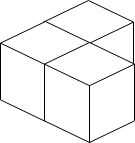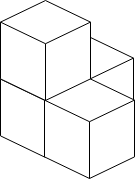Problem
You have a cubic storeroom where the width, length, and height of the room are all equal to n units. You are asked to place n boxes in this room where each box is a cube of unit side length. There are however some rules to placing the boxes:
You can place the boxes anywhere on the floor.
If box
xis placed on top of the boxy, then each side of the four vertical sides of the boxymust either be adjacent to another box or to a wall.
Given an integer n, return** the minimum possible number of boxes touching the floor.**
Example 1:

Input: n = 3
Output: 3
Explanation: The figure above is for the placement of the three boxes.
These boxes are placed in the corner of the room, where the corner is on the left side.
Example 2:

Input: n = 4
Output: 3
Explanation: The figure above is for the placement of the four boxes.
These boxes are placed in the corner of the room, where the corner is on the left side.
Example 3:

Input: n = 10
Output: 6
Explanation: The figure above is for the placement of the ten boxes.
These boxes are placed in the corner of the room, where the corner is on the back side.
Constraints:
1 <= n <= 10^9
Solution
class Solution {
static final double ONE_THIRD = 1.0d / 3.0d;
public int minimumBoxes(int n) {
int k = findLargestTetrahedralNotGreaterThan(n);
int used = tetrahedral(k);
int floor = triangular(k);
int unused = (n - used);
if (unused == 0) {
return floor;
}
int r = findSmallestTriangularNotLessThan(unused);
return (floor + r);
}
private int findLargestTetrahedralNotGreaterThan(int te) {
int a = (int) Math.ceil(Math.pow(product(6, te), ONE_THIRD));
while (tetrahedral(a) > te) {
a--;
}
return a;
}
private int findSmallestTriangularNotLessThan(int t) {
int a = -1 + (int) Math.floor(Math.sqrt(product(t, 2)));
while (triangular(a) < t) {
a++;
}
return a;
}
private int tetrahedral(int a) {
return (int) ratio(product(a, a + 1, a + 2), 6);
}
private int triangular(int a) {
return (int) ratio(product(a, a + 1), 2);
}
private long product(long... vals) {
long product = 1L;
for (long val : vals) {
product *= val;
}
return product;
}
private long ratio(long a, long b) {
return (a / b);
}
}
Explain:
nope.
Complexity:
- Time complexity : O(n).
- Space complexity : O(n).